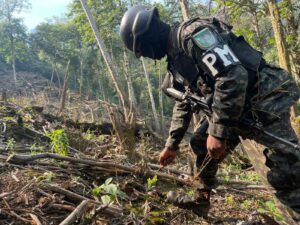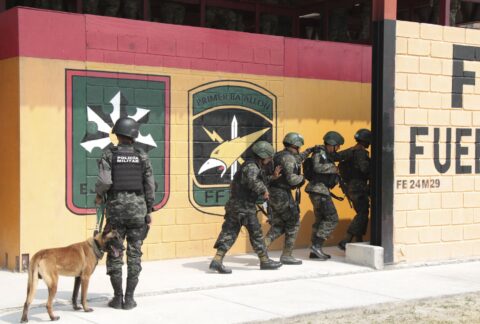Honduran security forces are having success in their fight against organized crime to curb the advances of coca cultivation in several areas of the country. According to the National Defense Secretariat (SEDENA), between January 1 and May 25, authorities destroyed 3 million coca bushes, dismantled 16 drug laboratories, and seized 11 coca fields.
The crops were located mainly in the northern part of the country, in departments such as Gracias a Dios, Olancho, Colón, El Paraíso, Atlántida, and Yoro. Plantations were even detected in parks and nature reserves.
“Honduras is considered a key territory in the narcotrafficking route and is it advancing in all its modalities, from transit, consumption, and production to commercialization,” German Licona, a Honduran lawyer and security advisor, told Diálogo on June 4. “The [coca] crops have reached the heart of the reserves that our country has, such as the Río Plátano Biosphere, mountains listed as reserves and national parks.”
For instance, in early May, the Honduran Armed Forces located coca leaf crops in Pico Bonito National Park, in the municipality of La Masica, Atlántida department. Authorities eradicated 70,000 coca bushes, Honduran newspaper La Prensa reported.
Just days later, in mid-May, the Technical Criminal Investigation Agency, a specialized unit of the Attorney General’s Office in charge of prosecuting serious crimes with a strong social impact, seized 10 coca farms and a drug laboratory in a mountainous area of the municipality of Iriona, Colón department.

“Narcotrafficking has taken over our territories because we live in a very open area with a small population,” an indigenous Honduran told Spanish news agency EFE on May 28. “Organized crime works with ease, which is generating a lot of violence in our region.”
Insecurity and crime in Honduras are largely due to narcotrafficking and organized crime. There is even talk of an increase in the presence of criminal groups and gangs such as the Mara Salvatrucha and Pandilla 18, which are involved in narcotrafficking, extortion, kidnapping, and other violent crimes, Honduran news site HonduDiario reported.
But authorities are not letting up. Another important blow occurred on May 15 in the municipality of Patuca, Olancho department. In a mountainous area of another nature reserve, the National Anti-Drug Police Directorate, with support from the National Directorate of Special Forces, eradicated and incinerated more than 1 million coca bushes and 2 million seedlings in a nursery. The plantation was spread over 120 plots of land in a difficult to access area, the National Police said.
“We must hold coordination meetings with the U.S. Embassy and agencies specialized in combating narcotrafficking,” Licona said. “This coordination will allow us to track the airplanes, the boats used to transport narcotics, and to carry out satellite studies to determine the areas where deforestation is taking place, possibly for coca cultivation.”
“Greater law enforcement presence is required in the reserve areas where the cartels, particularly the Mexican and Colombian [cartels], are entering, to locate, eradicate, and destroy them,” Licona said. “The coca cultivation areas should also be georeferenced and a closer approach should be maintained with the communities in those areas, in order to raise awareness and gather information.”
Over the last decade, investigative organization InSight Crime indicated, detections of coca crops have steadily increased in Honduras, which could be evidence of the country’s transition from a Central American narcotrafficking corridor to a potential coca producer.









